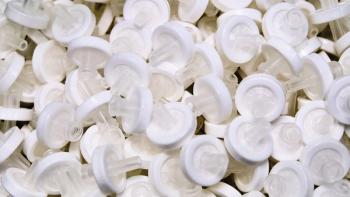
- BioPharm International-08-02-2013
- Volume 2013 Sponsored Supplement
- Issue 1
Virus Filtration Using a High-Throughput Parvovirus-Retentive Membrane
Test procedures for a surface-modified polyethersulfone hollow-fiber filter.
This article appears in a special supplement, A Renaissance in Biomanufacturing:The Art of Purification, published in August 2013.
Photo courtesy of Sartorius Stedim BiotechAll biotechnology products derived from animal sources carry a risk of contamination with viruses, including those endogenous to the source material, such as retroviruses (1) and those introduced adventitiously during manufacturing by personnel or contaminated raw materials. Viruses in biopharmaceutical products could potentially be transmitted to patients with dire consequences, particularly if the patient is immunocompromised (2). However, no such events have been reported in the context of recombinant proteins produced by fermentation because of the rigorous safety standards applied during manufacturing, including dedicated steps for virus removal and/or inactivation and a program of tests to ensure these steps are efficient, based on the guidelines set out in ICH Q5A (2).
Current regulatory guidelines require at least two orthogonal steps for the inactivation and/or removal of viruses, thus different principles of separation/inactivation must be used in each method (2,3). Because viruses vary in size, charge, and the presence or absence of an envelope, the available methods differ in their effectiveness against particular types of virus; these factors must be integrated into the design space during the development of a process ahead of Phase I clinical trials. Manufacturers are also expected to deliver a virus clearance strategy that has been optimized for each product because biopharmaceuticals are often large, complex proteins that resemble smaller viruses in their physical and chemical properties. Virus clearance strategies must, therefore, be tailored to avoid product loss. The virus removal steps must then be tested against at least two model viruses representing those most likely to be present in the process stream (2-3) and should include an endogenous virus if relevant to the process. Ideally, an adventitious virus such as minute virus of mice (MVM) or porcine parvovirus (PPV) should also be tested, because these are the gold standards for size-dependent clearance steps using 20-nm filters (2-4). Removal/inactivation is usually demonstrated in spiking studies, where specific viruses are added deliberately to the process stream ahead of the relevant unit operations. Before Phase III clinical trials can be authorized, two further viruses must be tested if specific contaminants are likely in the process stream. The two testing schemes have different aims: general virus clearance is designed to test process robustness, whereas specific virus clearance using anticipated contaminants aims to ensure product safety (4).
Although virus clearance should be built into the design space on a product-by-product basis, several robust and effective strategies have become established in the industry (5-6). Appropriate methods for virus inactivation include heating/pasteurization or solvent/detergent treatments (7), although these may also have a significant negative impact on some recombinant proteins and are only effective against enveloped viruses. More often, a low-pH hold (8) is used for enveloped viruses if this is compatible with the buffer conditions in the process (e.g., during the production of monoclonal antibodies); exposure to ultraviolet light in the UVC range is used to inactivate all viruses by cross-linking the nucleic acids at 254 nm (9). Virus removal methods physically separate virus particles from the feed stream, and the most suitable methods are chromatography, where virus particles are captured by adsorption (10), and retentive filtration using 20-nm filters, which eliminates even the smallest viruses by size exclusion (2,4). However, there are currently no common standards for virus filtration. Instead, it is left to manufacturers to show, on a case-by-case basis, that their virus clearance steps are acceptable and efficient.
Filter Design and Validation
Figure 1a: Hollow fiber cross section. (All figures courtesy of the authors.)To overcome current limitations in virus filtration—and as a step toward the development of common standards—a high-performance, hollow-fiber parvovirus filter has been developed, which demonstrates robust retention at high transmembrane pressures. The unique structure of the membrane and its chemically modified surface address many of the limitations of current retentive filters.
Figure 1b: Comparison of a 0.8/2.4-m² process module and a 5-cm² laboratory module with vent filter for contained flushing.The Virosart HF filter (Sartorius-Stedim) features a surface-modified asymmetric polyethersulfone (PES) hollow-fiber membrane optimized for the manufacture of monoclonal antibodies (see Figure 1a). The membrane is characterized by a funnel-like pore size gradient designed to achieve the robust retention of parvoviruses under challenging conditions (such as high blockage or pressure release) without impeding the efficient transfer of high-molecular-weight proteins such as monoclonal antibodies. The membrane is surface-modified with a hydrogel-forming, low-binding polymer, to reduce the adsorption of soluble proteins and protein aggregates. The pore size gradient and the hydrogel are unique aspects of the membrane that contribute to its high performance. The hollow fibers can be packed densely into modules ranging in capacity from 5 cm² to 2.4 m², the latter presented as a presterilized 10-in single-use device (see Figure 1b). The capacity of the filter can be extended by combining it with the Virosart MAX adsorptive pre-filter, featuring an optimized polyamide microfiltration flat-sheet membrane in a homogeneous triple-layer configuration, with a nominal pore size of 0.1 µm.
Figure 2: Water flow rate in Virosart HF capsules taken from three individual lots of the 2.4-m² module. Each capsule lot was built from a different membrane lot. The average permeability is 170 liter/m²h bar.Validation of Virosart HF has proven the consistent performance of the product family. Figure 2 shows selected validation data (permeability of 2.4-m² process modules) for illustration. However, measures have been taken to ensure future product quality from lot-to-lot. Validated in-process as well as release tests are performed during the manufacture and release of Virosart HF membranes and modules according to pre-defined sampling plans to measure and monitor critical performance attributes of all product components.
Membrane testing includes in-process and lot release tests. Membrane performance release tests are executed on laboratory modules that have experienced the same manufacturing steps as laboratory or process modules that would be shipped to customers. Virosart HF modules are in-house integrity tested by air-diffusion as well as gamma irradiated. Three membrane release tests—bacteriophage PP7 retention in buffer, bacteriophage PP7 retention in human IgG (grab sample at 75% flux decay), and water permeability—are consequently performed on lab modules, which have also been flushed with water, dried, and then exposed to gamma irradiation. Protein filtration capacity is monitored while PP7 retention in buffered human IgG solution is determined. These release tests ensure that membrane performance items meet expected and validated levels.
In addition, Virosart HF modules are released based on a 100% inspection scheme. Water flow rate and integrity of each module is tested prior to shipment. Integrity testing is based on an air-diffusion test at 4.5 bar and modules subsequently released based on a correlation between diffusive flow rate and PP7 retention.
Figure 3: The performance of the Virosart HF module family was tested for scalability using the same batch of a buffered human lgG model protein stream (highly blocking) until 95% flux decay was achieved.The performance of the Virosart HF module family was tested for scalability using the same batch of a buffered human IgG at 2 g/L. Three different 5-cm² laboratory modules and one 0.8-m² process module were challenged at 2 bar differential pressure until 95% flux decay was achieved (see Figure 3). The volume vs. time filtration data for the three laboratory modules was averaged and compared to the corresponding data for the process module according to the filtered protein mass per filtration area. Figure 3 confirms that (based on the performance data gathered using 5-cm² devices) laboratory modules can be scaled-up to larger feed stream volumes and filter areas.
Figure 4: Virosart HF laboratory modules were challenged with a 10-20-g/L monoclonal antibody solution (pH 6-7, conductivity 4-8 mS/cm) spiked with 0.5% MMV. Experiments were carried out at constant flux at 120 L/m2h. The membrane was challenged with up to 7.4-kg antibody/m2 resulting in a permeability decay of more than 70%. A log reduction value of greater than 5 was achieved in both spike trials (Run B and Run C).The retentive capabilities of the Virosart HF filter were tested under worst-case conditions, by challenging with a 10-20-g/L monoclonal antibody solution (pH 6-7, conductivity 4-8 mS/cm) spiked with 0.5% MMV. Experiments were carried out at constant flux at 120 L/m²h. To implement worst-case load conditions, the membrane was challenged with more than 5.5-kg antibody/m² resulting in a permeability decay of more than 70%. Two spike trials and one control trial were conducted for comparison.
In all three trials, the transmembrane pressure increased over time but the pressure profiles varied slightly from run to run with the mass throughput ranging from 5.8 to 7.4 kg/m² (see Figure 4). The transmembrane pressure did not increase above 2.7 bar in any of the trials and thus remained below operating pressure. Breakthrough was observed in one of the spike trials but the other achieved complete retention. The log reduction values for the pooled permeate were 5.19 and 5.21, respectively (see Table I).
Table I: Summary of the filtration and MMV retention data for the control trial (Run A) and the two spike trials (Run B and Run C).These data show that Virosart HF achieves robust log reduction values of greater than 5 even under challenging conditions, thus meeting the retentive requirements of a high-performance parvovirus filter with minimal lot-to-lot variability.
Figure 5: PPV retention in a human lgG model protein feed stream at different degrees of flux decay, during post wash and in the final filtrate and wash pool executed at two different spike levels.The Virosart HF was next tested with a feed stream comprising PPV spiked buffered human IgG solution at a IgG concentration of 0.1 g/L. Two spike trials were carried out with different amounts of virus, the first containing 5x105 pfu/mL and the second 5x106 pfu/mL. The log reduction values were determined using permeate grab fractions taken at 25% and 90% flux decay. The log reduction value was also determined in the post-wash fraction and the overall filtrate and wash pool. As shown in Figure 5, Virosart HF achieved robust log reduction values for human viruses regardless of the extent of blockage. The log reduction value for PPV was also high in the post-wash fraction, resulting in an overall pool log reduction value >6 in both tests.
Figure 6: Analysis of the recovery flush of a 0.8-m² Virosart HF process module. The data shows that, already after 3 liter flushing per m² membrane area, 99% of protein is recovered.Finally, the flush volume required to achieve the recovery of the target protein was determined by monitoring the permeate stream using an in-line UV-detector at 280 nm (see Figure 6). A 0.8-m² Virosart HF module was challenged with a 2-g/L buffered human IgG model solution until ~40% flow decay was observed, and then the module was flushed with buffer at 2 bar differential pressure. The protein concentration in the permeate stream was calculated from the UV measurement based on a previously determined calibration curve. Flushing the membrane with 3 L/m² achieved 99% protein recovery.
Conclusion
The Virosart HF is a novel, high-performance parvovirus filter based on a surface-modified asymmetric PES hollow fiber membrane. Rigorous testing confirmed its consistently robust retentive properties and high filtration capacity under challenging conditions, including an inlet pressure of up to 5 bar, up to 90% blockage, loading of up to 7.4-kg antibody/m² and spiking with 0.5% PPV. The hollow fiber membrane can be packed densely into scalable modules with a small footprint ideal for single-use campaigns.
Acknowledgments
The authors would like to thank Amit Mehta, Alexander Seay, and John Salvador from Genentech, a member of the Roche Group, for their contributions and support of this development.
Susanne Roederstein is director purification technologies Europe and Volkmar Thom is director precipitation technologies, Sartorius Stedim Biotech GmbH, August Spindler Str. 11, 37079 Göttingen, Germany.
References
1. K.P. Anderson, M.A. Low, Y.S. Lie, G.A. Keller, M. Dinowitz. Virol. 181,305-311 (1991).
2. International Conference on Harmonization, Q5A. Viral safety evaluation of biotechnology products derived from cell lines of human or animal origin. (Geneva, Switzerland; 1998).
3. EMEA, Guideline on virus safety evaluation of biotechnological investigational medicinal product. EMA/CHMP/BWP/398498/2005; (2008)
4. CPMP, Note for guidance on quality of biotechnology products, viral safety evaluation of biotechnology products derived from cell lines of human or animal origin. CPMP/ICH/295/95; (London, 1997).
5. J.K. Walter, F. Nothelfer, W. Werz “Validation of viral safety for pharmaceutical proteins,” in Bioseparation and bioprocessing, vol 1. G. Subramanian, Eds., (Wiley-VCH, Weinhemim, Germany, 1998), pp. 465-496.
6. G. Sofer, D.C. Lister, J.A. Boose. BioPharm Int. Jun; Suppl, 37-42 (2003).
7. B. Horowitz A. Lazo, H. Grossberg, G. Page, A. Lippin, G. Swan. Vox Sang. 74 Suppl 1, 203-206 (1998).
8. K. Brorson, S. Krejci, K. Lee, E. Hamilton, K. Stein, Y. Xu. Biotechnol Bioeng. 82, 321-329 (2003).
9. J. Wang, A. Mauser, S.F. Chao, K. Remington, R. Treckmann, K. Kaiser, D. Pifat, J. Hotta. Vox Sang. 86, 230-8 (2004).
10. J.X. Zhou, T. Tressel, U. Gottschalk, F. Soalmo, A. Pastor, S. Dermawan, et al. J Chromatogr A. 1134 (1-2), 66-73 (2006).
Articles in this issue
over 12 years ago
The Future of Downstream Processing-2013over 12 years ago
Protein Purification Using Single-Use Technologyover 12 years ago
A Renaissance in Biomanufacturing: The Art of PurificationNewsletter
Stay at the forefront of biopharmaceutical innovation—subscribe to BioPharm International for expert insights on drug development, manufacturing, compliance, and more.




